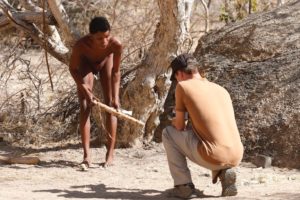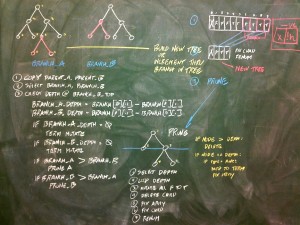Lost in Time

I have been in Namibia for the past ten days, working with a small film crew to capture footage for a teaser, which if successful, will raise funds to develop a film about the history of hunting, from the ancient San to modern day game preserves.
We are guests of the Immenhof ranch and game preserve (www.immenhofnamibia.com), four hours north and west of Windhoek.
The owners are four generations here as farmers, hunters, and custodians of the land. Of German heritage, the father and son speak six languages each, including the native languages of the Himba and Herero, with whom they were raised.
Yesterday we spent the afternoon and evening working with a few members of the Saan who participate in an exchange program, of sorts. They live here, away from their home land, for three months at a time, to share their stories and dance, sell handmade goods, and earn money to bring back to their tribe in the north east of Namibia and Botswana (which is unfortunately, spent mostly on alcohol and tobacco).
It was a very strange juxtaposition. The Saan are truly a relic of the past, caught in the crossfire of political struggles and selfish land-grabs. These will likely be the last of their people, tens of thousands of years of tradition lost to a world driven by Google advertising, mineral exploitation, and data mining.
I was a wary time traveler, for those brief hours, confused as to what I was seeing and hearing, and how I should interact. To pay them to assist with re-enactments for our film was a kind of prostitution, yet to sit and engage in deeper conversation was also self-serving. To leave them completely alone is to watch them starve in a place and time no longer able to support their traditional ways.
Werner, grandson of the founder of this ranch, PH, and expert tracker trained by the San, states he can arrange for me to live with them for a few weeks or more. I would be able to capture their stories, both historic and modern.
I stated I would do so only if they saw value in my work with them. He quickly replied, “Then you should not go to them.” According to his experience, the Saan do not see the need for their stories to be captured, but they are too polite to tell the BBC, Nat Geo, or any other camera crew (including our own) they are not interested in what we come to do.
It is, perhaps, our perception of history, some kind of duty to record what we have destroyed, that brings us into their world with anthropologists, cameras, and audio recorders.
My life would be changed if I could have that time with them, yet what would I be giving back to the San?
Outside of the obvious value to airtime and DVD sales, how does Nat Geo embrace these kinds of opportunities? Is there an altruistic motivation, even if those being interviewed do not perceive the same?
Today I worked behind the scenes to support Ron, Betsy, and Rhett (the DP) with their work on a ‘sizzler’ for a film about the history of hunting. Professional hunter, guide, and 3rd generation at the Immenhoff Ranch, Werner took us to a local “exchange” village of Saan, where we conducted brief interviews and shot a segment of the film.
I have deeply mixed feelings about what I experienced today, for it was a crossroads of tens of thousands of years of human history juxtaposed with modern world in a most stark composition.
There is no going back, no return to that time. These people continue to live as they have, to some degree, but with the daily reminder that their world was taken from them. Gone are the game, the unfenced, open land. Yet as Ron stated to clearly, “These people don’t know about ISIS nor do they concern themselves with the crumble of the Greek economy.”
It is far too easy for a well-to-do to romanticize the simple life, so I will stop here. But even those few hours with them reminded me why I sold everything I own three years ago–to keep things simple, to slow down, to pursue stories, nor ownership of more things.



















